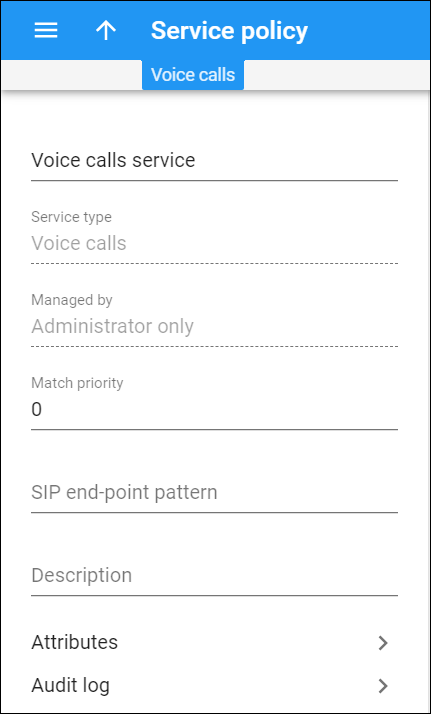On this panel you can change service policy details. Note that some fields are read-only. To save your changes, click Save.
Name
Edit the service policy name. The name should be unique for the particular service type.
Service type
This is a read-only field that shows the service type this policy is used for. You select the service type (Voice calls, Messaging service, or Internet access) during the service policy creation and it can’t be edited further.
This is a read-only field that shows the entity this service policy is managed by. Voice calls and Messaging service policies are managed by the administrator by default. For Internet access service policies this field can show a particular reseller name (you choose it during the Internet service policy creation and it can’t be changed further).
Match priority
This is only used for policies that match dynamically (Voice service policies must have the SIP end-point pattern field filled and Messaging service policies must have the Recipient domain pattern field filled). So, if more than one service policy matches, then the one with the highest priority is used.
SIP end-point pattern
This field is available for Voice calls service policies and specifies a pattern for the user agent (UA) type. If this field is filled, PortaSIP uses its value to dynamically match against every new call from/to internal accounts. If the specified pattern matches the caller/callee UA type, the policy attributes apply to this call. This field can contain either a full UA name (e.g., Linksys/SPA941-5.1.8) or a list of patterns separated by a comma (e.g., Cisco%,Sipura%,Grandstream%).
Recipient domain pattern
This field is available for Messaging service policies and specifies the recipient’s domain name or CLD. If this field is filled, PortaSIP uses its value to dynamically match against every new message from/to internal accounts. If the specified pattern matches the recipient domain, the policy attributes (i.e., transport protocol, routing and billing parameters) are used for processing and delivery of messages (both SMS and instant messages). For example, if you want to allow your end users to send SMS messages to any mobile network, type %. If you only allow end users to send SMS to a specific mobile operator, specify the pattern as follows: %XXX% (e.g., %380% for all mobile operators in Ukraine or %38050% for Vodafone Ukraine). Thus, when a user sends an SMS to +38055551122, PortaSIP matches the number with the pattern (e.g., %380%) and applies the service policy attributes.
Description
This is a short description of the service policy.
Also, this field is used in the Internet service policy to configure Sharing an Internet quota among multiple devices (you can specify “verify_mac=alias” or “verify_mac=customer” to activate the NetAccessVerifyMAC module).
Access policy
Available for Internet access service policies only. Open the Access policy panel to define how an end user is allowed to access the Internet (Regular, Turbo, Limited, or Blocked access types).
Access policy includes:
-
a scheduling table, which designates the type of access used during each time period;
-
specific values for the allowed upload/download speed for each type.
Attributes
Click on this tab to access groups of attributes that you can configure within the service policy.
Hotlining
Available for Internet access service policies only. Open the Hotlining panel to configure hotlining options – the redirection of Internet users to a specific website where they can quickly find information on how to subscribe or pay for the Internet service if their traffic quota or balance is insufficient for using the Internet.
Audit log
Click on this tab to trace the changes made to this service policy.



